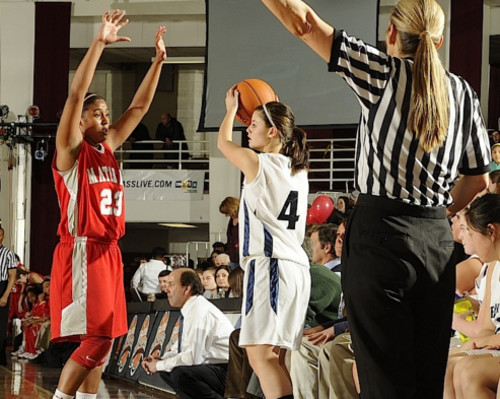Improving your Muscle Memory – Making Good Technique Automatic
By Cheryl McCarthy-Chiari on October 25, 2014 officials PrintIf you play golf, do you ever wonder why the pros seem to be able to hit the ball almost exactly where they want every time, while you’re slicing, hooking, or shanking much more often than not? Pro golfers, especially those on the PGA and LPGA tours, can do what they do so well because they have practiced their golf swing thousands upon thousands of times over a period of years, usually starting at a very early age. Tiger Woods was hitting golf balls beautifully at the age of three.
Muscle Memory is “learned motion”
The golf swing is not a natural motion. It’s a learned motion. Precision, repeatability and consistency come only after a lot of repetition to the point that the swing becomes instinctive and the golfer no longer has to think about it. That is the holy grail of the sport, and it’s a prefect example of what is called “muscle memory.”
Muscle memory can be developed for almost any sport or physical activity – including officiating. That’s a good thing, but ONLY, if what you’re practicing and training your muscles to do are the correct movements for the sport you officiate. If you develop bad habits and repeat them, they become part of your muscle memory, too, and that’s not going to help you advance in your officiating career.
The key for an official is to work hard to do things correctly the first time and every time after that until those correct movements and actions become part of your muscle memory. That has been my constant goal as a high school and college basketball official.

Cheryl McCarthy-Chiari working the Hall of Fame Classic in Connecticut. Photo by Richard Orr.
Applying muscle memory to basketball officiating
When I began officiating basketball, I constantly checked to see if I was in the correct position, given the action on the court. I reminded myself every time to raise my arm straight and strong after every whistle and make the proper signal. I had to will myself to hustle to the table and report a foul and communicate to the table crisply and correctly. These actions were not yet instinctive. But I worked at it. I would walk around the block at night and work on my signals. I watched myself on tape. I looked in the mirror. Eventually the proper actions and movements became part of my muscle memory. I didn’t have to think about doing the right things. I just instinctively did them. That freed me up to sharpen the mental components of my game – rules knowledge, play selection, judgment, game management, patience with the whistle, and all those other fine points that separate the good officials from the not-so-good and the great from the good.
But, that’s just basketball. What about other sports? To find out, I asked a couple of my fellow basketball officials, who also work other sports, about what they practice to train their muscle and mental memory and become better at their craft.
The Football Perspective
One of my colleagues, Jim Brennan, is a fine basketball official as well as an extremely accomplished and well respected Division I college football official. He’s worked games involving numerous big time programs, including in 2013, the Michigan vs. Notre Dame game that drew the largest crowd in college football history.
While football and basketball are very different games from an officiating perspective, the mindsets are very similar when it comes to developing good habits and making them instinctive. Here are some of Brennan’s observations:
- The type of play and your crew position dictate your movement. For example, if you’re a linesman or line judge, you’re going to be moving with the play parallel to the sideline and, when the play ends, stop and mark the forward progress spot on a 90-degree angle. Square it off and do not pinch in on the angle. If you’re a side judge downfield and the play is headed toward the end zone, you get to the goal line. If the play is coming straight at you, you may back off, but always stay in line with the goal line so you have a good look at the goal line plane. These are techniques you are taught. You practice, you repeat, and they should become instinctive.
- When it comes to mechanics, you and your crewmates must be consistent. You work on them so that they also become part of your muscle memory.
- Beyond mechanics, our crew is focused on being consistent with one another and throughout each game to the point that the coaches know what they are going to get from us and that it’s going to be good, solid and professional.
Umpiring the muscle memory way
Baseball is totally different from football and basketball in terms of the pace of the game and the specific in-game responsibilities of the umpires. But the work ethic is and should be the same. The really good umpires develop proper techniques and mechanics. They practice and repeat them until they are instinctive, freeing up their eyes and mind to see the play from the best possible position and make the correct ruling.
Another basketball officiating colleague of mine, John Basso, is also a veteran baseball umpire who has worked for more than 30 years at the high school level and all college division levels. While he, too, has committed the correct actions to muscle memory, he still constantly works on these things and is always learning. Here are some of his thoughts:
- I’ve learned to never take my eyes off the ball and to stay ready for whatever may happen next. Know the situation, anticipate the play, but not the call. For example, if there are runners on first and second and nobody out, I would anticipate a potential bunt so as not to be surprised if it happens.
- Timing is key. I’ve worked at being deliberate – not taking overly long but being deliberate enough in my actions and calls so as to make fewer mistakes.
- Positioning is another key. When behind the plate, and a right handed hitter is up, I try to set up the same way for that hitter and every subsequent right hand hitter, and be similarly consistent in how I set up for every left handed hitter. When calling balls and strikes, I try to have my head high enough to see the pitch well but not too high. If I’m the base umpire in a crew of two and there is an infield grounder, I try to set up in a 90-degree angle from the origin of the throw to get the best look at the ball, the throw, the catch and the runner. This is all basic stuff, but you have to do it often and regularly to the point that you don’t have to think about it. You just do it, which gives your brain more freedom to process each play and make the correct call.
Practice, practice, practice
I thank my colleagues for their input and observations. They and I agree that if you want to become an accomplished official for any sport, you have to put in a lot of time, not just during the season but throughout the offseason as well. That’s how you build your muscle memory and your mental memory and keep them both in top shape. Every good and proper technique you can store in your memory will serve you well on the court or field of play. Your good habits will become part of you. You will do the right things automatically, without thinking about them. You will gain confidence, strength and credibility. Justifiably, you will be able to take greater pride in your work.
The bottom line is this: Practice really does make perfect, but only if you practice “The Right Stuff.”
Cheryl McCarthy-Chiari
Cheryl McCarthy-Chiari is a Board 10 official in New Haven, Connecticut, and a Division II and Division III women’s college official. She’s also a liaison to the IAABO Women’s Coordinating Committee.
Most Recent Articles
- nfhs news NFHS Learning Center Delivers 25 Millionth Course
- Track & Field/Cross Country article Effective Communication with Athletes and Coaches
- nfhs news Player Equipment Changes Highlight 2025 High School Football Rules Revisions
- Player Equipment Changes Highlight 2025 High School Football Rules Revisions
- nfhs news Judgment Call on Second Contact Eliminated in High School Volleyball






